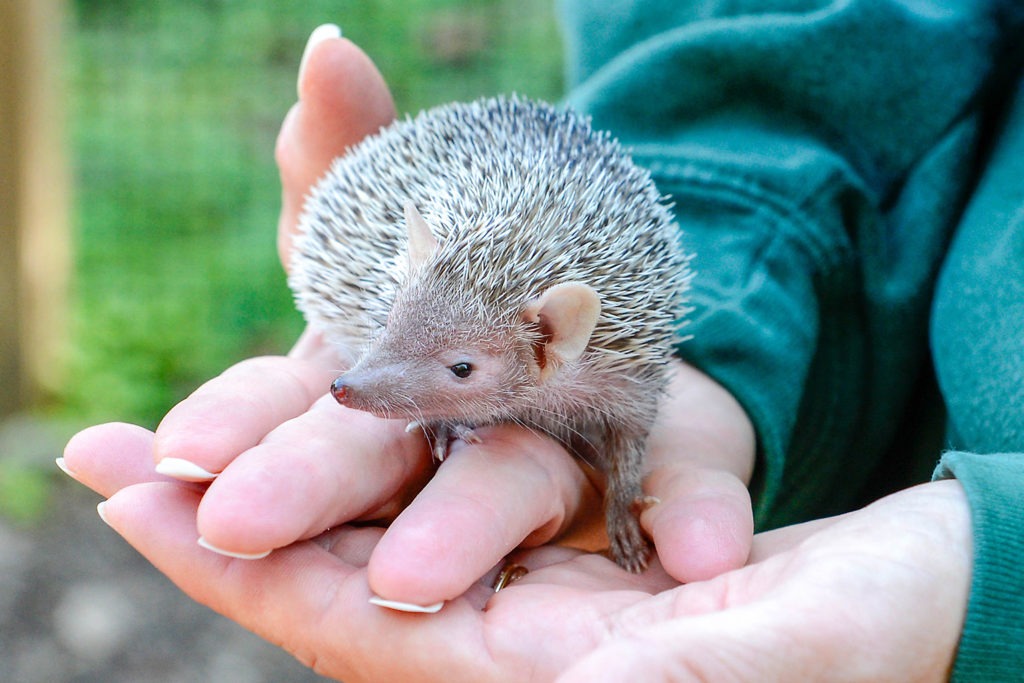Overview
“Where I live”
Lesser hedgehog tenrecs live in dry forested areas of southern and southwestern Madagascar.
The Maryland Zoo features lesser hedgehog tenrecs among its Animal Ambassadors, which are introduced to audiences in education programs on and off grounds.
“How I live there”
Lesser hedgehog tenrecs spend their days sleeping and their nights gobbling up insects along with other food. They look like miniature hedgehogs but are not closely related, despite the name. They are solitary animals that forage alone, except for mothers with young. They scurry around on the ground and in trees, and use their sharp claws for tree-climbing. Their eyesight is poor but they rely on excellent senses of hearing and touch to navigate their night-time world. For three to five months during the dry season, if food becomes particularly scarce, these animals are able to enter a state of inactivity known as torpor.
“Making my mark”
Lesser and greater hedgehog tenrecs are the only tenrec species completely covered in spines. The spines are modified hairs.
Raising Young
Females give birth to litters of 1 to 10 young after a gestation period of about 7 weeks. The young weigh only about one-quarter of an ounce at birth but develop quickly and become independent in about one month.
“What eats me”
When threatened, lesser hedgehog tenrecs curl up in a ball, leaving only their sharp spines exposed. As effective a deterrent as this may be, the tiny animals are still vulnerable to predation by birds of prey, snakes, and some other carnivores.
Conservation
Lesser hedgehog tenrecs are listed as a species of least concern by the IUCN, the world’s leading conservation organization. The species is thought to be widely distributed with a stable population.
Taxonomy
- Kingdom: Animalia
- Phylum: Chordata
- Subphylum: Vertebrata
- Class: Mammalia
- Order: Afrosoricida
- Family: Tenrecidae
- Genera: Echinops
- Species: telfairi
What is an Animal Ambassador?
The Maryland Zoo refers to its special collection of education program animals as “Animal Ambassadors.” The Zoo currently cares for more than 60 Animal Ambassadors, representing more than 40 species, both native and exotic. These animals are managed separately from the rest of the Zoo’s collection and cannot be seen on exhibit at the Zoo. However, many can be seen up close and personal on a rotating basis at Creature Encounters, the Zoo’s outdoor education center; at camp and school programs at the Zoo; as featured participants in community-based Outreach programs; and at special events on and off Zoo grounds.
Animal Ambassadors spend countless hours working with their human handlers, developing bonds of trust and communication that will allow them to appear in front of audiences large and small. They are not show animals. They behave naturally, focusing audiences’ attention on their natural behaviors and adaptations and giving living, breathing meaning to concepts and topics that students may be studying.
Animal Ambassadors travel all over the state of Maryland and beyond, and many also make local and national media appearances, educating about wildlife while representing the Zoo and its commitments to animal welfare and conservation.
What is The Animal Embassy?
The Animal Embassy at The Maryland Zoo is an off-exhibit area that is not open to the public. It is where the Zoo’s “Animal Ambassadors,” or education program animals, live. The Embassy is home to more than 60 individual animals representing more than 40 different species. It is staffed by its own dedicated group of keepers and volunteers and has both indoor and outdoor living space for the animals.


